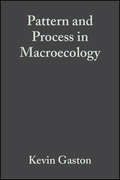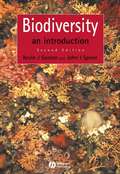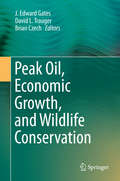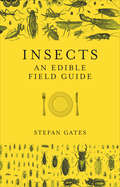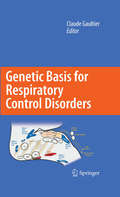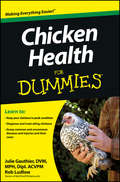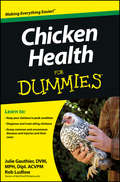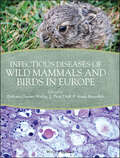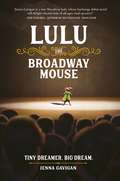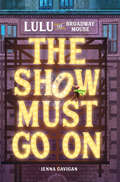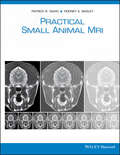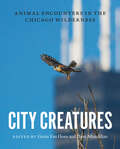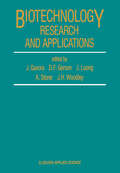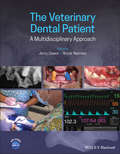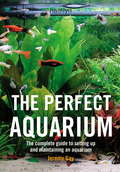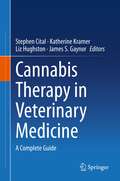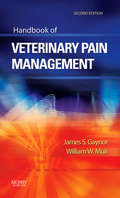- Table View
- List View
Pattern and Process in Macroecology
by Kevin Gaston Tim BlackburnIssues of scale have become increasingly important to ecologists. This book addresses the structure of regional (large-scale) ecological assemblages or communities, and the influence this has at a local (small-scale) level. This macroecological perspective is essential for the broader study of ecology because the structure and function of local communities cannot be properly understood without reference to the region in which they are situated. The book reviews and synthesizes the issues of current importance in macroecology, providing a balanced summary of the field that will be useful for biologists at advanced undergraduate level and above. These general issues are illustrated by frequent reference to specific well-studied local and regional assemblages -- an approach that serves to relate the macroecological perspective (which is perhaps often difficult to comprehend) to the everyday experience of local sites. Macroecology is an expanding and dynamic discipline. The broad aim of the book is to promote an understanding of why it is such an important part of the wider program of research into ecology. Summarises the current macroecological literature. Provides numerous examples of key patterns. Explicitly links local and regional scale processes. Exploits detailed knowledge of one species assemblage to explore broad issues in the structuring of biodiversity.
Biodiversity: An Introduction
by Kevin J. Gaston John I. SpicerCLICK HERE TO DOWNLOAD ARTWORK This concise introductory text provides a complete overview of biodiversity - what it is, how it arose, its distribution, why it is important, human impact upon it, and what should be done to maintain it. Timely overview of the serious attempts made to quantify and describe biodiversity in a scientific way Acts as an easy entry point into the primary literature Provides real-world examples of key issues, including illustrations of major temporal and spatial patterns in biodiversity Designed primarily with undergraduate students and course lecturers in mind, it will also be of interest to anyone who requires an overview of, and entry to, the vast literature on these topics. All the figures included in the book are downloadable from the Blackwell Publishing website
Biodiversity: An Introduction
by Kevin J. Gaston John I. SpicerCLICK HERE TO DOWNLOAD ARTWORK This concise introductory text provides a complete overview of biodiversity - what it is, how it arose, its distribution, why it is important, human impact upon it, and what should be done to maintain it. Timely overview of the serious attempts made to quantify and describe biodiversity in a scientific way Acts as an easy entry point into the primary literature Provides real-world examples of key issues, including illustrations of major temporal and spatial patterns in biodiversity Designed primarily with undergraduate students and course lecturers in mind, it will also be of interest to anyone who requires an overview of, and entry to, the vast literature on these topics. All the figures included in the book are downloadable from the Blackwell Publishing website
Peak Oil, Economic Growth, and Wildlife Conservation
by J. Edward Gates David L. Trauger Brian CzechThe proposed book focuses on one of the most important issues affecting humankind in this century - Peak Oil or the declining availability of abundant, cheap energy—and its effects on our industrialized economy and wildlife conservation. Energy will be one of the defining issues of the 21st Century directly affecting wildlife conservation wherever energy extraction is a primary economic activity and indirectly through deepening economic recessions. Since cheap, abundant energy has been at the core of our industrial society, and has resulted in the technological advancements we enjoy today, the peak in world oil extraction would potentially have major impacts on civilization unless we prepare well in advance. One potential economic solution covered in the book would be a Steady State Economy with a stable population and per capita consumption, particularly in such industrialized countries as the United States. Furthermore, the lack of cheap, abundant energy directly and indirectly affects conservation efforts by professional societies and federal and state agencies, and NGOs concerned with wildlife issues. We need to recognize these potential problems and prepare, as much as possible, for the consequences stemming from them.
Insects: An Edible Field Guide
by Stefan GatesEver been tempted by the thought of trying juicy deep fried mealworms, proteinrich cricket flower, or swapping your Walkers for salt and vinegar flavoured grasshoppers? If so then you are not alone! Over 2 billion people regularly eat insects as part of their diet, and the world is home to around 1,900 edible insect species.For adventurous foodies and daring dieters comes the newest way to save the planet, eat more protein, and tickle taste buds. But this isn’t an insect cookbook. Instead it’s an informative field guide: exploring the origins of insect eating, offering tips on finding edible bugs and serving up a few delicious ideas of how to eat them once you’ve tracked them down! It includes a comprehensive list on edible insects and where to find them, how to prepare them, their versatile usage and nutritional value as well as a few recipes. A bug-eating checklist covering all known edible bugs so readers can mark off the ones they’ve eaten and seek out new delicacies concludes the book.This is a perfect introduction to the weird, wonderful, and adventurous side of entomophagy.
Biology of Brain Dysfunction: Volume 1
by Gerald E. GaullThe growth of neurochemistry, molecular biology, and biochemical genetics has led to a burgeoning of new information relevant to the pathogenesis of brain dysfunction. This explosion of exciting new information is crying out for collation and meaningful synthesis. In its totality, it defies systematic summa tion, and, of course, no one author can cope. Thus invitations for contributions were given to various experts in areas which are under active investigation, of current neurological interest, and pregnant. Although this project is relatively comprehensive, by dint of size, other topics might have been included; the selection was solely my responsibility. I believe systematic summation a virtual impossibility-indeed, hardly worth the effort. The attempt to assemble all of the sections involved in a large treatise with multiple authors inevitably results in untoward delays due to the difference in the rate at which various authors work. Therefore, the following strategy has been adopted: multiple small volumes and a relatively flexible format, with publication in order of receipt and as soon as enough chapters are assembled to make publication practical and economical. In this way, the time lag between the ideas and their emergence in print is the shortest.
Biology of Brain Dysfunction: Volume 2
by Gerald E. GaullThe growth of neurochemistry, molecular biology, and biochemical genetics has led to a burgeoning of new information relevant to the pathogenesis of brain dysfunction. This explosion of exciting new information is crying out for collation and meaningful synthesis. In its totality, it defies systematic summa tion, and, of course, no one author can cope. Thus invitations for contributions were given to various experts in areas which are under active investigation, of current neurological interest, and pregnant. Although this project is relatively comprehensive, by dint of size, other topics might have been included; the selection was solely my responsibility. I believe systematic summation a virtual impossibility-indeed, hardly worth the effort. The attempt to assemble all of the sections involved in a large treatise with mUltiple authors inevitably results in untoward delays due to the difference in the rate at which various authors work. Therefore, the following strategy has been adopted: multiple small volumes and a relatively flexible format, with publication in order of receipt and as soon as enough chapters are assembled to make publication practical and economical. In this way, the time lag between the ideas and their emergence in print is the shortest.
Biology of Brain Dysfunction: Volume 3
by Gerald E. GaullThe growth of neurochemistry. molecular biology, and biochemical genetics has led to a burgeoning of new information relevant to the pathogenesis of brain dysfunction. This explosion of exciting new information is crying out for collation and meaningful synthesis. In its totality, it defies systematic summa tion, and, of course, no one author can cope. Thus invitations for contributions were given to various experts in areas which are under active investigation, of current neurological interest, and pregnant. Although this project is relatively comprehensive, by dint of size. other topics might have been included; the selection was solely my responsibility. I believe systematic summation a virtual impossibility-indeed, hardly worth the effort. The attempt to assemble all of the sections involved in a large treatise with multiple authors inevitably results in untoward delays due to the difference in the rate at which various authors work. Therefore, the following strategy has been adopted: multiple small volumes and a relatively flexible format, with publication in order of receipt and as soon as enough chapters are assembled to make publication practical and economical. In this way, the time lag between the ideas and their emergence in print is the shortest.
Genetic Basis for Respiratory Control Disorders
by Claude GaultierBringing together top-level contributions on all aspects of the subject, this book provides an overview of the recent advances in the genetics of respiratory control in health and disease. It also shows how combined studies in humans and mouse models have helped to improve our understanding of the mechanisms that underlie genetically determined respiratory control disorders with the goal of developing new therapeutic interventions.
Chicken Health For Dummies
by Julie Gauthier Rob LudlowEverything you need to care for and keep happy, healthy chickens With directives on diagnosing and treating sick or ailing chickens, as well as general information on how to keep chickens in peak condition, Chicken Health For Dummies is your go-to guide on how to best care for and keep chickens. Inside, you'll get everything you need to know about chicken health and wellness: an encyclopedia full of common and not-so-common diseases, injuries, symptoms, and cures that chicken owners may encounter. Chicken Health For Dummies provides chicken owners with one handy, all-encompassing resource. Helps you identify potential hazards and signs of ill health in your chicken Shows you how to properly examine chickens to identify and isolate potential health issues before they spread to the rest of the flock An encyclopedia full of common and uncommon diseases, injuries, symptoms, and cures for chickens Chicken Health For Dummies joins Raising Chickens For Dummies and Building Chickens Coops For Dummies to round out the For Dummies reference library as a must-have resource for both rural and urban chicken owners.
Chicken Health For Dummies
by Julie Gauthier Rob LudlowEverything you need to care for and keep happy, healthy chickens With directives on diagnosing and treating sick or ailing chickens, as well as general information on how to keep chickens in peak condition, Chicken Health For Dummies is your go-to guide on how to best care for and keep chickens. Inside, you'll get everything you need to know about chicken health and wellness: an encyclopedia full of common and not-so-common diseases, injuries, symptoms, and cures that chicken owners may encounter. Chicken Health For Dummies provides chicken owners with one handy, all-encompassing resource. Helps you identify potential hazards and signs of ill health in your chicken Shows you how to properly examine chickens to identify and isolate potential health issues before they spread to the rest of the flock An encyclopedia full of common and uncommon diseases, injuries, symptoms, and cures for chickens Chicken Health For Dummies joins Raising Chickens For Dummies and Building Chickens Coops For Dummies to round out the For Dummies reference library as a must-have resource for both rural and urban chicken owners.
Infectious Diseases of Wild Mammals and Birds in Europe
by Dolores Gavier-Widén J. Paul Duff Anna MeredithInfectious Diseases of Wild Mammals and Birds in Europe is a key resource on the diagnosis and treatment of infectious diseases in European wildlife that covers the distinctive nature of diseases as they occur in Europe, including strains, insect vectors, reservoir species, and climate, as well as geographical distribution of the diseases and European regulations for reporting, diagnosis and control. Divided into sections on viral infections, bacterial infections, fungal and yeast infections, and prion infections, this definitive reference provides valuable information on disease classification and properties, causative agents, epidemiology, pathogenesis, and implications for human, domestic and wild animal health. Key features: • Brings together extensive research from many different disciplines into one integrated and highly useful definitive reference. • Zoonotic risks to human health, as well as risks to pets and livestock are highlighted. • Each disease is covered separately with practical information on the animal species in which the disease has been recorded, clinical signs of the disease, diagnostic methods, and recommended treatments and vaccination. • Wildlife vaccination and disease surveillance techniques are described. • Examines factors important in the spread of disease such as changing climate, the movement of animals through trade, and relaxations in the control of wide animal populations.
Infectious Diseases of Wild Mammals and Birds in Europe
by Dolores Gavier-Widen Anna Meredith J. Paul Duff Dolorés Gavier-WidenInfectious Diseases of Wild Mammals and Birds in Europe is a key resource on the diagnosis and treatment of infectious diseases in European wildlife that covers the distinctive nature of diseases as they occur in Europe, including strains, insect vectors, reservoir species, and climate, as well as geographical distribution of the diseases and European regulations for reporting, diagnosis and control. Divided into sections on viral infections, bacterial infections, fungal and yeast infections, and prion infections, this definitive reference provides valuable information on disease classification and properties, causative agents, epidemiology, pathogenesis, and implications for human, domestic and wild animal health. Key features: • Brings together extensive research from many different disciplines into one integrated and highly useful definitive reference. • Zoonotic risks to human health, as well as risks to pets and livestock are highlighted. • Each disease is covered separately with practical information on the animal species in which the disease has been recorded, clinical signs of the disease, diagnostic methods, and recommended treatments and vaccination. • Wildlife vaccination and disease surveillance techniques are described. • Examines factors important in the spread of disease such as changing climate, the movement of animals through trade, and relaxations in the control of wide animal populations.
Lulu the Broadway Mouse (The Broadway Mouse Series)
by Jenna GaviganRatatouille meets Broadway in this charming new middle grade novel about a little mouse with big dreams. Lulu is a little girl with a very big dream: she wants to be on Broadway. She wants it more than anything in the world. As it happens, she lives in Broadway's Shubert Theatre; so achieving her dream shouldn't be too tricky, right? Wrong. Because the thing about Lulu? She's a little girl mouse. When a human girl named Jayne joins the cast of the show at the Shubert as an understudy, Lulu becomes Jayne's guide through the world of her theatre and its wonderfully kooky cast and crew. Together, Jayne and Lulu learn that sometimes dreams turn out differently than we imagined; sometimes they come with terms and conditions (aka the company mean girl, Amanda). But sometimes, just when we've given up all hope, bigger and better dreams than we'd ever thought could come true, do.
Lulu the Broadway Mouse: The Show Must Go On (The Broadway Mouse series)
by Jenna GaviganLulu's show has just received its closing notice. Lulu and the rest of the company are devastated. Lulu takes readers back in time to just after she made her onstage debut and of Lulu and Jayne rising in popularity and esteem. However, there is one critic who is determined to break Lulu's career. With additional casting drama happening with Jayne, Amanda, and new girl Olivia, the news about the show closing comes as a real blow to everyone. When Benji, Lulu's brother, comes up with an idea on how to boost ticket sales, the company members hit the streets, desperate to save the show from closing. But will Lulu and Stella be able to stop the nasty critic from completely ruining Lulu's dreams and those of the rest of the cast?
Practical Small Animal MRI
by Patrick R. Gavin Rodney S. BagleyPractical Small Animal MRI is the seminal reference for clinicians using Magnetic Resonance Imaging in the diagnosis and treatment of veterinary patients. Although MRI is used most frequently in the diagnosis of neurologic disorders, it also has significant application to other body systems. This book covers normal anatomy and specific clinical conditions of the nervous system, musculoskeletal system, abdomen, thorax, and head and neck. It also contains several chapters on disease of the brain and spine, including inflammatory, infectious, neoplastic, and vascular diseases, alongside congenital and degenerative disorders.
Practical Small Animal MRI
by Patrick R. Gavin Rodney S. BagleyPractical Small Animal MRI is the seminal reference for clinicians using Magnetic Resonance Imaging in the diagnosis and treatment of veterinary patients. Although MRI is used most frequently in the diagnosis of neurologic disorders, it also has significant application to other body systems. This book covers normal anatomy and specific clinical conditions of the nervous system, musculoskeletal system, abdomen, thorax, and head and neck. It also contains several chapters on disease of the brain and spine, including inflammatory, infectious, neoplastic, and vascular diseases, alongside congenital and degenerative disorders.
City Creatures: Animal Encounters in the Chicago Wilderness
by Gavin Van Horn and Dave Aftandilian Dave AftandilianWe usually think of cities as the domain of humans—but we are just one of thousands of species that call the urban landscape home. Chicago residents knowingly move among familiar creatures like squirrels, pigeons, and dogs, but might be surprised to learn about all the leafhoppers and water bears, black-crowned night herons and bison, beavers and massasauga rattlesnakes that are living alongside them. City Creatures introduces readers to an astonishing diversity of urban wildlife with a unique and accessible mix of essays, poetry, paintings, and photographs. The contributors bring a story-based approach to this urban safari, taking readers on birding expeditions to the Magic Hedge at Montrose Harbor on the North Side, canoe trips down the South Fork of the Chicago River (better known as Bubbly Creek), and insect-collecting forays or restoration work days in the suburban forest preserves. The book is organized into six sections, each highlighting one type of place in which people might encounter animals in the city and suburbs. For example, schoolyard chickens and warrior wasps populate “Backyard Diversity,” live giraffes loom at the zoo and taxidermy-in-progress pheasants fascinate museum-goers in “Animals on Display,” and a chorus of deep-freeze frogs awaits in “Water Worlds.” Although the book is rooted in Chicago’s landscape, nature lovers from cities around the globe will find a wealth of urban animal encounters that will open their senses to a new world that has been there all along. Its powerful combination of insightful narratives, numinous poetry, and full-color art throughout will help readers see the city—and the creatures who share it with us—in an entirely new light.
City Creatures: Animal Encounters in the Chicago Wilderness
by Gavin Van Horn and Dave Aftandilian Dave AftandilianWe usually think of cities as the domain of humans—but we are just one of thousands of species that call the urban landscape home. Chicago residents knowingly move among familiar creatures like squirrels, pigeons, and dogs, but might be surprised to learn about all the leafhoppers and water bears, black-crowned night herons and bison, beavers and massasauga rattlesnakes that are living alongside them. City Creatures introduces readers to an astonishing diversity of urban wildlife with a unique and accessible mix of essays, poetry, paintings, and photographs. The contributors bring a story-based approach to this urban safari, taking readers on birding expeditions to the Magic Hedge at Montrose Harbor on the North Side, canoe trips down the South Fork of the Chicago River (better known as Bubbly Creek), and insect-collecting forays or restoration work days in the suburban forest preserves. The book is organized into six sections, each highlighting one type of place in which people might encounter animals in the city and suburbs. For example, schoolyard chickens and warrior wasps populate “Backyard Diversity,” live giraffes loom at the zoo and taxidermy-in-progress pheasants fascinate museum-goers in “Animals on Display,” and a chorus of deep-freeze frogs awaits in “Water Worlds.” Although the book is rooted in Chicago’s landscape, nature lovers from cities around the globe will find a wealth of urban animal encounters that will open their senses to a new world that has been there all along. Its powerful combination of insightful narratives, numinous poetry, and full-color art throughout will help readers see the city—and the creatures who share it with us—in an entirely new light.
Biotechnology Research and Applications
by J. Gavora D. F. Gerson J. Luong A. Storer J. H. WoodleyHistorically, ruminant animals have provided farmers with the ability to utilize marginal lands for the production of high quality food for human consumption. Ruminants are able to derive their nourishment from feeds that are not in themselves capable of meeting the nutritional needs of the animal. They do this by supporting in the rumen, which is a greatly enlarged region of the stomach which precedes the animals digestive system, a microbial fermentation system. This system partially degrades complex polysaccharides and provides to the animal not only the degradation products (chiefly volatile fatty acids), but also secondary microbial metabolites and microbial biomass (most importantly microbial protein, which can be synthetized from inorganic nitrogen sources). A ruminant animal is able to survive, if not thrive, on a diet containing only cellulose, a non-protein nitrogen source such as urea, and trace minerals. The capacity of the rumen to process low quality feeds is limited by factors such as rumen volume, the time required for digestion of these feeds in the rumen, and the ability of the animal to chew the feed. Hodern ruminant animals have been intensively selected for high production potential, but the limited capacity of the rumen fermentation means that this potential cannot be realized by feeding the animal low quality feeds. The high production potential of these animals can only be realized by feeding large amounts of readily digestible, high quality feeds such as oilseed meals and grains.
The Veterinary Dental Patient: A Multidisciplinary Approach
by Jerzy Gawor Brook NiemiecProvides an interdisciplinary approach to the veterinary dental patient and offers guidance on all aspects of integrating dentistry into veterinary general practice The Veterinary Dental Patient: A Multidisciplinary Approach helps veterinarians understand the dental aspects of every canine and feline patient and shows them how to effectively manage their oral health. It also provides guidance to the rest of the veterinary team so they can offer a coordinated approach when recommending and performing veterinary dentistry as a regular part of general practice. Edited by two prominent veterinary dentists who are Board Certified in both Europe and the United States, the text includes the latest information on safe anesthetic and monitoring protocols, accurate diagnosis and management, and referring patients to specialists. Chapters cover: establishing a dental presence in general veterinary practice; nutrition, oral health, and feeding dental patients; local, regional, and systemic complications of dental diseases; pain management; ophthalmic considerations; common situations for malpractice and mistakes; oral and maxillofacial surgery; extraction techniques and equipment; drug dosages and more. The book also offers several helpful appendixes. The Veterinary Dental Patient: A Multidisciplinary Approach is an essential book for all vets in general small animal practice as well as the wider veterinary team, including managers, veterinary nurses and technicians, and administrative staff.
The Veterinary Dental Patient: A Multidisciplinary Approach
by Jerzy Gawor Brook NiemiecProvides an interdisciplinary approach to the veterinary dental patient and offers guidance on all aspects of integrating dentistry into veterinary general practice The Veterinary Dental Patient: A Multidisciplinary Approach helps veterinarians understand the dental aspects of every canine and feline patient and shows them how to effectively manage their oral health. It also provides guidance to the rest of the veterinary team so they can offer a coordinated approach when recommending and performing veterinary dentistry as a regular part of general practice. Edited by two prominent veterinary dentists who are Board Certified in both Europe and the United States, the text includes the latest information on safe anesthetic and monitoring protocols, accurate diagnosis and management, and referring patients to specialists. Chapters cover: establishing a dental presence in general veterinary practice; nutrition, oral health, and feeding dental patients; local, regional, and systemic complications of dental diseases; pain management; ophthalmic considerations; common situations for malpractice and mistakes; oral and maxillofacial surgery; extraction techniques and equipment; drug dosages and more. The book also offers several helpful appendixes. The Veterinary Dental Patient: A Multidisciplinary Approach is an essential book for all vets in general small animal practice as well as the wider veterinary team, including managers, veterinary nurses and technicians, and administrative staff.
The Perfect Aquarium: The Complete Guide to Setting Up and Maintaining an Aquarium
by Jeremy GayEverything the first time fish-keeper needs to know to set up a tank. Clear, easy-to-follow instructions help you create and develop your aquarium - whether it's coldwater, tropical or marine. Charts and tables show how to deal with ailments and diseases, and there's a guide to the most common fish. There are profiles of over 100 tropical, marine and coldwater fish, as well as plants and invertebrates.
Cannabis Therapy in Veterinary Medicine: A Complete Guide
by James S. Gaynor Stephen Cital Katherine Kramer Liz HughstonThis book provides in-depth information on the applications of cannabis products as a legitimate medicine in treating a variety of diseases and disorders in domestic animals. Pharmacology and toxicology of cannabinoids and their effects on the endocannabinoid system, which is involved in the regulation of diverse physiological and cognitive processes, are discussed in detail. Furthermore, the book reviews development and testing of cannabis based medical products and introduces the nutritional components of cannabis plants. Cannabis as a therapeutic in veterinary medicine is gaining interest among owners and practitioners. Numerous studies have been completed or are currently underway that analyze the potential of clinical application of cannabinoid and terpenoid molecules. In this book the authors take a comprehensive look at previous studies in animal and human models and discuss translational applications based on these scientific data. This seminal text serves as a go-to resource for veterinary practitioners on cannabinoid therapy. It will also serve as a foundation for clinicians and researchers interested in this emerging field of veterinary medicine.
Handbook of Veterinary Pain Management - E-Book
by James S. Gaynor William W. Muir IIIYou can trust this user-friendly guide to help you meet the increasing need for effective pain management in the animals you treat. It provides instant access to clinically relevant information on pain assessment, pharmaceutical and non-pharmaceutical treatment options, guidelines for managing acute and chronic pain, and unique aspects of pain management in dogs, cats, horses, cattle, birds, reptiles, ferrets, and rabbits.User-friendly format helps you quickly and easily find essential pain management information.Helpful boxes and tables provide at-a-glance access to pharmacologic protocols and clinical applications, including dosages, indications, contraindications, and side effects.Complementary and alternative treatment strategies are included throughout to assist you in using the latest non-pharmacological pain interventions.Case studies clearly illustrate the practical applications of key concepts in the clinical setting and help you sharpen your pain assessment and management skills.New contributors — many of the most respected experts in the field — share their insights and experiences to bring you the most current thinking in this ever-changing discipline.Completely revised and updated content throughout ensures you are using the best and most current information available on analgesic drugs and pain management techniques.An expanded chapter on Pain Management in Horses and Cattle explores the latest advances in treating this group of animals.Eight new chapters offer cutting-edge coverage of hot topics in the field, including:Pain Management in the CatPain Management for the Pet BirdClinical Approaches to Analgesia in ReptilesClinical Approaches to Analgesia in Ferrets and RabbitsPhysical Therapy and Rehabilitation in DogsRehabilitation Methods and Modalities for the CatQuality of Life IssuesHospice and Palliative Care
